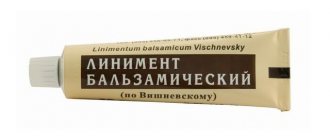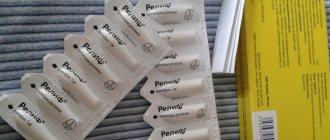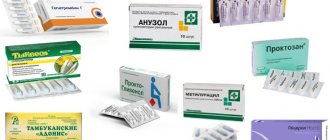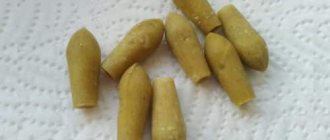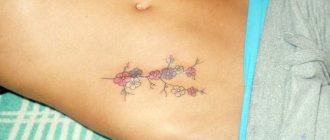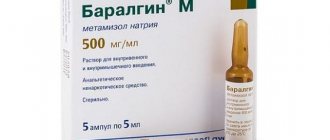Hemorrhoids are a common problem among breastfeeding women. It can appear during pregnancy due to stagnation of blood, constant pressure on the pelvic area by the growing uterus, constipation, after childbirth due to straining and for other reasons. Therefore, it is important to know which suppositories for hemorrhoids can be used during breastfeeding in order to alleviate the symptoms of the disease and not harm the baby.
The safety of using suppositories to treat diseases during lactation depends on the active ingredients. Many drugs contain components that pass into breast milk and can harm the baby. If such suppositories are still needed to treat the mother, then breastfeeding should be stopped for the period of therapy. These include drugs such as Aurobin, Proctosan, Relief Advance, Proctosedyl and others.
Anestezol
The antihemorrhoidal medicine contains 4 active ingredients (bismuth, benzocaine, zinc and menthol), which together have a pronounced local anesthetic, astringent and anti-inflammatory effect. Anestezol suppositories eliminate pain, reduce the intensity of inflammation, accelerate the healing of damaged tissues and facilitate bowel movements.
When breastfeeding, 1 suppository is prescribed 1-2 times a day.
Gepatrombin G
The drug contains prednisolone, polidocanol, sodium heparin. The medicine is a direct-acting anticoagulant; when administered rectally, it has antiexudative, antithrombotic and anti-inflammatory effects. Gepatrombin G suppositories promote the healing of damaged tissue, reduce inflammation and associated symptoms (pain, burning, itching) in the anal area. Prescribed for the treatment of hemorrhoids (internal and external), anal fissures, itching, fistulas, eczema, thrombophlebitis of the anal veins. Rectally, suppositories are administered 1-2 times a day after bowel movements.
Attention! The drug is contraindicated for viral, bacterial, fungal infections of the skin, syphilis, tuberculosis, skin tumors, predisposition to bleeding.
Features of the choice of drugs for hemorrhoids during breastfeeding
Pregnancy is a natural state, but, unfortunately, during this period, women often develop or worsen existing hemorrhoids. The reason for this lies in the fact that when carrying a child, a large load is placed on the vessels of the anus, therefore, if there is a hereditary predisposition, then it is quite difficult to avoid this pathology.
Hemorrhoids can occur both during pregnancy and during labor. During childbirth, the blood flow to the hemorrhoidal veins sharply increases, which cannot cope with this load, so they overflow, expand and turn into hemorrhoids.
If hemorrhoids occur during pregnancy, then during childbirth the nodes fall out.
There are a number of factors that provoke postpartum hemorrhoids:
- constipation;
- sedentary lifestyle;
- unbalanced diet with a lack of plant fiber and a predominance of protein products;
- difficult course of labor;
- hormonal changes in the body.
The very first sign of hemorrhoids is discomfort in the rectum, which intensifies after defecation. But, unfortunately, after giving birth, the mother is busy caring for the child, so she does not pay enough attention to her health and does not always pay attention to the first “bells” of hemorrhoids, while the disease progresses.
Over time, the woman begins to experience pain and itching in the anus when visiting the restroom. Also, during bowel movements, you may notice streaks of blood on the stool and drops of blood on toilet paper.
External nodes can be felt independently in the area of the anal ring from the first stage of the disease, while internal hemorrhoids begin to fall out only from the second stage. There is also a risk of developing complications such as anorectal thrombosis, the formation of anal tears, strangulation of nodes, etc.
Timely treatment, which should be prescribed exclusively by a specialist, will help to avoid the progression of hemorrhoids and the development of complications. Self-medication during lactation is unacceptable, since you can harm not only your body, but also the health of the baby.
According to experts, the safest and most effective suppositories that are suitable for treating hemorrhoids during breastfeeding are the following:
- candles with sea buckthorn oil;
- Natalsid;
- Posterisan;
- Neo-Anuzol;
- Procto-Glyvenol;
- Relief;
- Gepatrombin G.
Let's take a closer look at the listed drugs.
Ingredients: sea buckthorn oil.
Healing properties: accelerate the healing of anal tears, relieve inflammation in the tissues of the anus and help normalize blood circulation.
Indications: hemorrhoids, anal tears, inflammation of the rectum.
Contraindications: allergy to the components of suppositories, diarrhea, pancreatitis, bile duct and gall bladder stones.
Dose and regimen: rectally, one insert in the morning and evening for 1 - 2 weeks. The course of treatment can be repeated after a month.
Cost: from 85 to 130 rubles.
Natalsid
Ingredients: sodium alginate is a substance obtained from the processing of sea brown algae.
We suggest you familiarize yourself with the Orthopedic pillow for hemorrhoids - is it worth buying?
Medicinal properties: the medication eliminates bleeding of hemorrhoids and fissures, accelerates the healing of anal tears and reduces the severity of the inflammatory process in the anus.
Indications: bleeding hemorrhoids, anal tears, recovery period after surgery on the rectum.
Contraindications: allergy to sodium alginate and other ingredients of suppositories, age under 14 years.
Dose and regimen: rectally, one suppository 2 times a day for 1-2 weeks.
Cost: from 430 to 480 rubles.
Posterisan
Ingredients: phenol-inactivated E. coli.
Medicinal properties: the drug effectively eliminates inflammation in the tissues of the rectum, strengthens local immunity, relieves itching and promotes epithelization of anal tears.
Indications: internal hemorrhoids, anal tears, recovery after anal surgery, anal itching.
Contraindications: allergy to phenol.
Dose and regimen: rectally, one suppository 2 times a day for 14 - 21 days.
Cost: from 350 to 400 rubles.
Neo-Anuzol
Ingredients: bismuth and zinc compounds, tannin, iodine, resorcinol, methylene blue.
Healing properties: the drug destroys pathogens in the anus, dries weeping wounds and covers them with a protective film, accelerating healing, relieves pain and itching, eliminates inflammation and spasm of the anal ring muscles.
Indications: hemorrhoids, anal tears.
Contraindications: individual intolerance to the ingredients of the suppositories.
Dose and regimen: rectally, one insert two or three times a day, depending on the severity of symptoms. The course of treatment is determined by the attending doctor.
Cost: from 120 to 140 rubles.
Procto-Glyvenol
Ingredients: lidocaine and tribenozide.
Medicinal properties: tribenozide increases the tone and strength of the vessels of the rectum, due to which blood circulation is normalized, bleeding is prevented, inflammation and swelling are stopped. Lidocaine is a local anesthetic, thanks to which the drug instantly eliminates pain and itching in the anus.
Indications: internal hemorrhoids.
Contraindications: individual intolerance to the ingredients of the drug, the first 12 weeks of gestation and severe liver dysfunction.
Dose and regimen: rectally, one suppository twice a day, after which they switch to a maintenance dose of the drug - one suppository once a day.
Cost: from 430 to 500 rubles.
Ingredients: phenylephrine and cocoa butter.
Medicinal properties: phenylephrine has a vasoconstrictor effect, which normalizes blood circulation in the vessels of the anorectal area, stops bleeding, eliminates swelling and inflammation in the tissues. Cocoa butter effectively softens the skin and accelerates the healing of anal tears.
Indications: hemorrhoids and anal tears.
Contraindications: individual intolerance to the ingredients of suppositories, tendency to thrombosis, decreased level of granulocytes in the blood.
Dose and regimen: rectally, one insert four times a day. The course of treatment is determined by the attending doctor.
Cost: from 390 to 420 rubles.
Gepatrombin G
Ingredients: heparin, lauromacrogol, prednisolone.
Medicinal properties: antithrombotic, venosclerotic, healing, anti-inflammatory, analgesic.
Indications: hemorrhoids, anal tears, anorectal thrombosis, anal itching.
Contraindications: individual intolerance to the ingredients of suppositories, nonspecific and specific infectious processes of the skin of the anus, active rectal bleeding, the first 12 weeks of gestation.
Dose and regimen: rectally, one insert 1 - 2 times a day, depending on the severity of symptoms. The course of treatment is determined by the attending doctor, but not more than 10 days.
Cost: from 170 to 200 rubles.
We suggest you familiarize yourself with Rectal suppositories for the treatment of hemorrhoids
Nursing mothers should definitely know how to properly use suppositories for hemorrhoids. The following algorithm will help with this:
- Bowel movement.
- Wash with warm water without soap or a weak solution of potassium permanganate.
- Drying the skin of the anal area with a soft, lint-free cloth.
- Thorough hand washing with soap and treatment with manual antiseptic.
- A comfortable position is lying on your left side or standing with your legs slightly apart.
- Release the suppository from the packaging.
- Spreading the buttocks with one hand and inserting a candle into the anus with the other hand to a depth of 3 - 4 cm.
- Washing hands with soap.
After the procedure, you need to squeeze your buttocks and lie down for 30-40 minutes so that the drug does not leak out of the rectum.
Etiology of the disease
Hemorrhoids form when the expectant mother is pregnant. During childbirth, the veins of the rectum become congested and enlarge. This is the main reason that causes the formation of a node. Systematic constipation and stool disturbances in a nursing mother lead to hemorrhoids. In case of vascular insufficiency, the disease manifests itself during breastfeeding and pregnancy. The pathological process of formation of hemorrhoids during breastfeeding is associated with the following factors:
- Prolonged or rapid labor. Contractions increase the level of blood pressure in the abdominal cavity. This can cause external hemorrhoids to appear.
- Problems with stool. If a woman has constipation and heavy bowel movements immediately after childbirth, she may develop the disease.
- I carry it heavier. If during breastfeeding (BF) the mother lifts weights, this provokes and increases blood flow to the venous dilations. So, a hemorrhoidal lump appears.
- Poor mobility of a woman. During the postpartum period, congestion occurs in the pelvis.
Mom is better off using safe medications in the form of suppositories.
It is important to consider that dangerous components can be absorbed into the mother’s blood and the child’s body along with milk. It is allowed to treat a woman’s illness during lactation with antihemorrhoidal drugs, but there are a number of conditions for them:
- the medicine must be absolutely safe for mothers and babies;
- For nursing mothers, suppositories, ointment or cream are more suitable;
- the doctor allows the use of a minimally invasive procedure to remove the hemorrhoid;
- Prevention prevents relapse.
If you consult a doctor on time, then in the initial stages of hemorrhoid formation, you can completely cure it by resorting to conservative therapy. In complex forms of the disease, it is necessary to remove the hemorrhoid using a minimally invasive procedure or radical surgery to remove the inflamed node.
Ichthyol
Candles have an anti-inflammatory, antiseptic, and analgesic effect. They eliminate inflammation, normalize blood circulation in inflamed tissues, relieve pain, and heal cracks and wounds. The drug is recommended for use at the initial stage of the disease; in advanced cases, they will be ineffective.
It is enough to administer ichthyol suppositories once a day, as their effect lasts 12-24 hours.
Methyluracil
The medicine has a regenerative, anabolic, anti-inflammatory, and immunostimulating effect. Improves tissue trophism, promotes healing of cracks and wounds, reduces inflammation. Prescribed for ulcerative and erosive colitis, hemorrhoids, proctitis, sigmoiditis, mechanical injuries and anal fissures.
Attention! During lactation, the doctor may prescribe the use of 1 to 8 suppositories per day, depending on the stage of the pathology.
What causes blood pressure to drop?
If the relationship between kidney pathologies and high blood pressure has been tracked, you should know what causes low blood pressure. Low pressure does not always indicate renal pathologies, however, if the patient has already encountered problems with the filtration organs, you should check whether the low pressure indicates renal dysfunction.
Natalsid
Contains sodium alginate, which improves blood clotting, reducing bleeding from hemorrhoidal veins, and has an anti-inflammatory and antispasmodic effect. When used, an intensive process of tissue regeneration occurs, pain and the intensity of inflammation decrease. The medicine is indicated for the chronic form of bleeding hemorrhoids and anal fissures.
Suppositories are prescribed, 1 piece twice a day for 7-14 days. The doctor can adjust the frequency of use, dosage and duration of treatment, depending on the stage of the disease and the severity of symptoms. The drug is contraindicated in case of individual intolerance to active and auxiliary substances.
Age-related changes
Systolic and diastolic pressure are responsible for the work and condition of the circulatory system of the human body as a whole.
Is the upper pressure renal or cardiac? The systolic (upper) pressure is formed when the heart pumps out the next batch of blood.
In other words, the tonometer records the strength of the heart’s impulse, which is why it is called cardiac. There is an opinion that the more often the heart beats, the higher the first number on the tonometer will be, but this is partly true, and partly a misconception. For example, when consuming substances that promote vasodilation, such as alcohol, upper blood pressure increases, but the heart, to compensate for the load, slightly reduces its work.
Thus, after drinking alcohol, blood pressure first jumps sharply and later returns to normal. But such systematic experiments with the circulatory system can eventually provoke hypertension, which is already considered a disease requiring special drug treatment.
What does kidney pressure mean in humans?
Lower pressure, also known as diastolic pressure, characterizes the condition of the blood vessels.
This indicator is recorded at the moment when the heart has pumped out blood again and is in a relaxed state. At this moment, the tonometer records the blood pressure on the walls of large vessels in the human body.
It is called renal because it is the work of the kidneys that forms this indicator. With pathological kidney diseases, fluid stagnation can form in the patient’s body, sodium ions are retained in the blood, and this leads to swelling of the walls of blood vessels.
Cardiac and renal pressure are closely interconnected; only with a certain balance of indicators does the patient feel good, there is no danger to life and health.
Increased renal pressure, lower or upper cardiac pressure, signals problems in the body.
If the indicators jumped sharply and after a short period of time returned to normal, then there is no need to worry, because the reasons may be physical activity, nervous shocks, both alarming and joyful.
These are factors that can affect the circulatory system spontaneously, but do not bring a person much discomfort or affect well-being. High blood pressure signals heart problems, but unstable lower kidney pressure is considered a more acute problem.
Most often, in the presence of diseases, the patient is diagnosed with high renal pressure. This disease is medically called renal hypertension.
- pathological processes of the renal vessels. Pathologies of the blood vessels that go to the kidneys can be either congenital or acquired during life. Quite often, people are already born with a tendency to an aneurysm or thickening and proliferation of renal artery tissue, a decrease in the isthmus of the renal aorta. In almost 90% of children with renal hypertension, doctors detect vascular abnormalities during examination;
- diseases of the kidneys themselves: anomalies and inflammatory processes of tissues;
- bad habits, problems with excess weight, consumption of high-calorie and salty foods can damage healthy renal vessels and cause atherosclerosis, embolism and compression of the renal arteries, paranephritis.
- among pathological anomalies, neoplasms on the kidneys are distinguished in the form of cysts, oncological tumors, a reduced size of one or two kidneys at the same time, or thickening of tissue walls;
- Inflammatory kidney diseases include pyelonephritis and glomerulonephritis.
The symptoms of both pathologies are not very different, but there is still a clear difference: renal hypertension is not so often aggravated by crises, heart attack, or stroke
The symptoms of both pathologies are not very different, but there is still a clear difference: renal hypertension is not so often aggravated by crises, heart attack, or stroke. In addition, with renal destruction, almost immediate swelling of the soft tissues is observed. A sign of an increase or decrease in the amount of urine will help to track low or high blood pressure. In particular, before blood pressure increases, urine volume decreases significantly.
Any pathological process in the kidneys is associated with pressure and causes a decrease or increase in the production of pressor (increasing pressure) or depressor (lowering pressure) substances. But a change in pressure level leads to a slowdown in blood flow in the kidney, which provokes unpleasant symptoms in the patient.
A decrease in pressure due to renal pathologies is an extremely rare phenomenon and each time requires an individual examination by a specialist. The most common option is increased blood pressure due to kidney problems, such as:
- hyperplasia is a congenital disease characterized by proliferation of the walls of the renal artery;
- coarctation - narrowing of the isthmus of the artery;
- arterial aneurysm;
- vascular atherosclerosis;
- embolism – blockage of the renal artery;
- sclerosing pyelonephritis;
- external compression of the renal arteries.
Kidney hypertension differs according to two indicators: renovascular or associated with diffuse (acquired) lesions.
- Vasorenal pathology is the most common, occurring even in children (90% of cases). With adult patients, the diagnosis is confirmed in 50-60% of cases.
- Diffuse hypertension is caused by damage to the tissue of the renal organs. There can be both congenital pathology in the form of: hypoplasia, absence of a part or a complete organ, the presence of cysts, formations, and an inflammatory process - this is pyelonephritis, glomerulonephritis.
Systolic and diastolic (upper/lower) pressure is an indicator of the functioning of the cardiovascular system. Impaired kidney function may affect the indicators, but may indicate heart disease. Therefore, careful diagnosis and examination is required to identify the cause. The lower level, like the renal level, is judged by the presence of diseases of the filtering organs.
There are no special symptoms of pathology. The kidneys signal themselves only by swelling, usually of the lower extremities, some malaise, and pain in the lower back (of varying intensity). But all the signs can also indicate a malfunction of the cardiovascular system.
Systolic blood pressure clearly indicates disturbances in the functioning of the heart and its blood vessels. Pathologies of other organs do not affect this figure in any way! Therefore, when analyzing the question: is upper pressure cardiac or renal, the answer is cardiac.
Cardiac and renal pressure are closely interconnected; only with a certain balance of indicators does the patient feel good, there is no danger to life and health.
Since from the above information it is clear that blood pressure is measured in two main indicators: upper (systolic) and lower (diastolic), they are also called cardiac and renal.
That is, the lower pressure is the renal pressure. Blood pressure reflects the work of the whole body.
First, you need to understand in more detail the names of the two types of blood pressure so that there is no confusion. So, upper pressure is also called cardiac and arterial pressure. And the lower (diastolic) has another name - renal.
Systolic best characterizes the performance of the heart. But diastolic is the main indicator of the health of all human blood vessels.
Few people understand why low blood pressure is associated with kidney function. Everything is quite simple.
And all because its level is regulated by the functionality of the kidneys. If any alarming inflammatory process begins in the human body, then the lower pressure fully reflects this.
Normal values are as follows: 110/71 mmHg. Art. or 120/79 mm Hg. Art. Moreover, minor deviations are not a pathology, since each human body has its own individual characteristics. It is important to remember that lower pressure is not heart pressure.
Sphygmomanometer
But, if significant fluctuations and deviations from the norm are constantly observed, then this already indicates serious health problems. This should cause some concern, since hypertension and hypotension are not common conditions.
In this case, you should immediately contact specialists for help. As you know, blood pressure is measured using a special device called a sphygmomanometer. Once it has become clear what pressure is considered cardiac - upper or lower, it is necessary to understand the causes of hypotension and hypertension.
Neo-Anuzol
The drug contains substances (bismuth, zinc, tannin, resorcinol, iodine, methylene blue) that are not contraindicated for nursing mothers. Neo-Anuzol has an astringent, anti-inflammatory, analgesic, antispasmodic, drying and antiseptic effect. Suppositories are prescribed for the treatment of hemorrhoids, anal fissures or other injuries to the anus, in order to prevent or eliminate pain, irritation, burning, itching, bleeding and prevent infections.
Important! Suppositories are used from 1 to 3 pieces per day, depending on the severity of the condition. The course of treatment is 7-10 days. An absolute contraindication is hypersensitivity to the substances of the drug.
Age-related changes
With age, the normal blood pressure in adults gradually changes. The table and pulse together provide objective information about changes in the condition of the blood vessels. If the numbers at some point exceeded the patient’s usual norm, this is not yet a reason to panic - an increase of 10 mm Hg. Art. considered acceptable after physical activity, in a state of fatigue, after a long day of work. But a stable deviation over a long period of time is a sign of a developing pathology.
Sea buckthorn candles
The medicine is made on the basis of sea buckthorn seed oil. It contains vitamins A, C, F, E and K. Suppositories relieve inflammation, increase blood clotting, accelerate the healing of damaged tissue, prevent the formation of tumors, and have antibacterial properties. Indications for use: hemorrhoids, rectal ulcers, anal fissures, atrophic and catarrhal proctitis.
Nursing mothers are prescribed 1 suppository 1-2 times a day, depending on the severity of the pathology. The course of therapy is 2-3 weeks. At the initial stage of the disease, sea buckthorn suppositories are used as monotherapy, at 2 or 3 - in combination with other safe medications.
Working pressure - what is it?
This expression can be heard in everyday life. The concept of “working” pressure refers to those indicators at which a person feels comfortable, despite the fact that one or both of them - systolic and diastolic - are significantly increased or decreased. In general, this attitude towards oneself reflects only the desire to ignore the existing problem.
Cardiologists have no concept of a patient’s “working” pressure. Values above 140/90 in middle-aged individuals are classified as hypertension. The justification may be that with age, cholesterol accumulations are deposited on the walls of blood vessels, narrowing their lumen. There is no clinically serious deterioration, but the risk of developing pathology increases significantly.
Posterisan
Suppositories for hemorrhoids for nursing are characterized by the absence of side effects, even with long-term use. They stimulate the mother's immunity and heal wounds, cracks and ulcers on the mucous membrane, have an anti-inflammatory effect and prevent secondary infection. Used for burning and discharge from the anus and itching.
It is necessary to administer suppositories up to 4 times a day, the duration of therapy is 2-3 weeks.
Procto-Glyvenol
The active substances of the drug (lidocaine and tribenoside) relieve pain, the intensity of the inflammatory process, improve microcirculation, increase vascular tone, relieve the patient from itching and burning in the anorectal area. Rectal suppositories quickly eliminate unpleasant symptoms, thereby improving the general condition of a woman during breastfeeding.
Attention! Procto-Glyvenol is prescribed for acute hemorrhoids, 1 suppository twice a day. After the condition improves, switch to a dose of 1 suppository once a day. When breastfeeding, the drug is prescribed if the effect of its use exceeds all possible risks. There is no need to stop lactation during the course of therapy. The medicine is contraindicated in case of hypersensitivity to the active components.
Basic rules for choosing medications during lactation
In order to avoid possible complications, when choosing candles you should pay close attention to the following points:
- carefully ensure that the composition does not contain components that are potentially dangerous to the baby;
- give preference to drugs that are made from natural ingredients;
- choose medications that suit your symptoms, for example, for external hemorrhoids, it is best to choose an ointment rather than a suppository;
- pay attention to the active components of suppositories, as some of them are able to relieve itching, others help heal cracks, and others destroy pathogenic microflora.
When choosing suppositories for hemorrhoids, always consult with your doctor, who will prescribe the most effective option and conduct a thorough diagnosis.
Propolis DN
The medicine based on bee propolis is safe during lactation, has an anti-inflammatory and wound-healing effect. The only contraindication is individual intolerance to bee products, which can be passed on to the child.
Suppositories must be inserted into the rectum, 1 piece three times a day for 10 days.
Relief
This remedy is prescribed quite often during lactation. It does not contain components that can negatively affect the baby's health; all substances pass into breast milk in minimal quantities.
Shark liver oil included in the suppositories relieves inflammation, accelerates the healing of tissues, wounds and cracks; Phenylephrine hydrochloride constricts blood vessels, relieves swelling, reduces blood flow to the veins in the area of hemorrhoidal cones, and prevents the release of exudate. The action of phenylephrine is aimed at eliminating symptoms such as pain, itching, burning, and bleeding.
Relief is prescribed for breastfeeding 2-4 times a day, depending on the severity of the disease. A suppository is inserted into the anus after hygiene procedures and bowel movements.
Important! It is forbidden to use suppositories for women with thromboembolic disease, granulocytopenia, or increased individual intolerance to the drug. It is allowed with caution in case of arterial hypertension, diabetes mellitus, hyperthyroidism, and urinary retention.
First symptoms
The “alarm bell” of hemorrhoids is noticeable discomfort in the anal area. This symptom is followed by the following problems:
- it hurts to go to the toilet, because with any tension or contact with a foreign object, hemorrhoids begin to hurt;
- irritation and itching of the skin around the anus;
- traces of blood on linen and toilet paper;
- You can feel the nodes in the anus.
At the first stage of the disease, venous nodes may not cause much discomfort. If you do not begin to eliminate the problem in time, the formations begin to fall out. The last stage of hemorrhoids is fraught with irreversibility of the process, and the nodes can only be corrected through surgery.
When hemorrhoids appear during pregnancy or after childbirth, a woman is often faced with a choice: carry out full treatment and wean the baby from the breast, or endure it while the lactation process takes place. Experts advise not to let the disease progress and to carry out treatment on time. Of course, it is prohibited to select medications on your own, but the doctor will advise which suppositories or ointments are best to choose.
The first thing you need to do is normalize your stool. Most medications for constipation or diarrhea are addictive to the body and also have a negative effect on a breastfed infant. That is why the safest remedy for hemorrhoids is suppositories and ointments for hemorrhoids during lactation.


